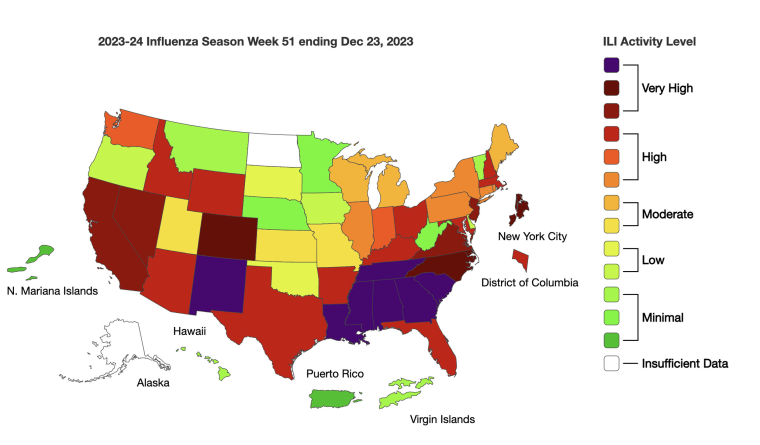As kids go back to school and families return to a post-holiday routine, flu season is on track to be a rough one in some states, especially in the Southeast and parts of the West, doctors say.
Thirty-three states are reporting high to very high case counts of influenza-like illnesses, and there have been about 4,500 flu-related deaths, including those of 20 children, since the 2023-24 season began in October.
Flu began to take off around Thanksgiving in Louisiana, which has one of the worst outbreaks in the country, said Dr. David Janz, the director of medical critical care services at University Medical Center New Orleans. About 20% of his critically ill patients are sick from influenza.
Flu cases are “increasing at a much faster rate that they had post-Thanksgiving,” said Janz, who treats adults. “By some measures, here in Louisiana, this looks like it’s probably going to be our worst influenza season since at least the 2009 H1N1 outbreak.”
That was one of the most severe flu seasons in decades, with an estimated 12,000 deaths nationally. Back then, H1N1 was a new flu strain, and it hit children particularly hard. In subsequent years, H1N1 has circulated seasonally, including this year.
Janz warned that other states should prepare for the flu virus, which is spreading fast at the same time as Covid and other respiratory viruses.
“This is not just a Southern issue,” he said.
Already, a number of states in the Northeast and the Midwest are reporting increases.

This time last year, flu cases had already peaked and were declining. Now, flu levels continue a steady path upward in the New Year.
Although ER visits among school-age children dipped last week while kids were home for winter break, flu overall isn’t dropping anywhere. The current season looks to be “pretty typical,” Dr. Mandy Cohen, the head of Centers for Disease Control and Prevention, said in an interview Wednesday.
“While we’re still on the upswing,” Cohen said, “we’re not see any big surges.”
The CDC estimates that there have been at least 7.1 million flu illnesses this season, with 73,000 hospitalizations. At least 14,732 people were admitted to the hospital for flu in the week that ended Dec. 23.
According to Cohen, there is no indication that the rises in flu or other respiratory illnesses like Covid are straining hospital systems yet.
Most patients sick enough to be hospitalized and die from flu are ages 65 and older.
Children, too, can get severely ill from flu, and it can be especially dangerous for kids ages 5 and younger. ER visits for flu among babies ages 1 and under rose significantly during the week that ended Saturday, the CDC reported.
North Carolina, which is in the midst of “very high” flu activity, has reported three pediatric deaths this year — already matching the number of children who died in the state during all of last year’s flu season, according to the state Department of Health and Human Services.
“We are definitely seeing a surge in cases of influenza right now,” said Dr. Jonathan Miller, the chief of primary care pediatrics for Nemours Children’s Health. “A lot of sick kids, a lot of sick families coming out of the holidays when everybody was getting together.” The Nemours system includes children’s hospitals and dozens of pediatricians in Delaware, Florida and Pennsylvania.
Dr. Amina Ahmed, a pediatric infectious diseases expert at Atrium Health Levine Children’s in Charlotte, North Carolina, said she has also noted the steady uptick in pediatric flu cases. Those young patients typically come in with fevers, cough and often either runny noses or sore throats, Ahmed said.
Both Ahmed and Miller of Nemours said that, anecdotally, it seems that the kids sick enough to be hospitalized with flu didn’t get this year’s flu shot.
“These kids are pretty much all unvaccinated,” Ahmed said. “The uptake on the influenza vaccine wasn’t as robust as we would have hoped.”
According to a CDC survey, just 43.9% of kids ages 6 months to 17 years received the flu shot this year. The survey estimated that about the same percentage of adults — 43.8% — said they got the shot.
The percentage tends to be lower in states like Louisiana, where Janz estimates that just 30% to 40% had had their flu vaccines.
Cohen said this year’s flu shot does seem to cover the influenza strains that are circulating: mostly H1N1, an influenza A strain. And, she said, there is still time to get the shot.
“We have weeks and weeks” of flu season to go, she said, “and maybe even a couple of months.”
Along with vaccinations, the CDC recommends:
- Getting tested for flu and Covid when you’re sick. There are antiviral medications for both illnesses, and they are best when given early.
- Practicing regular hand-washing.
- Staying home and away from others when you’re sick.









Recent Comments